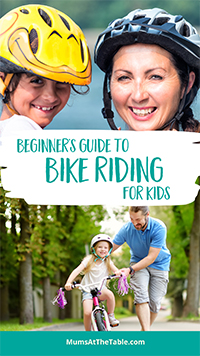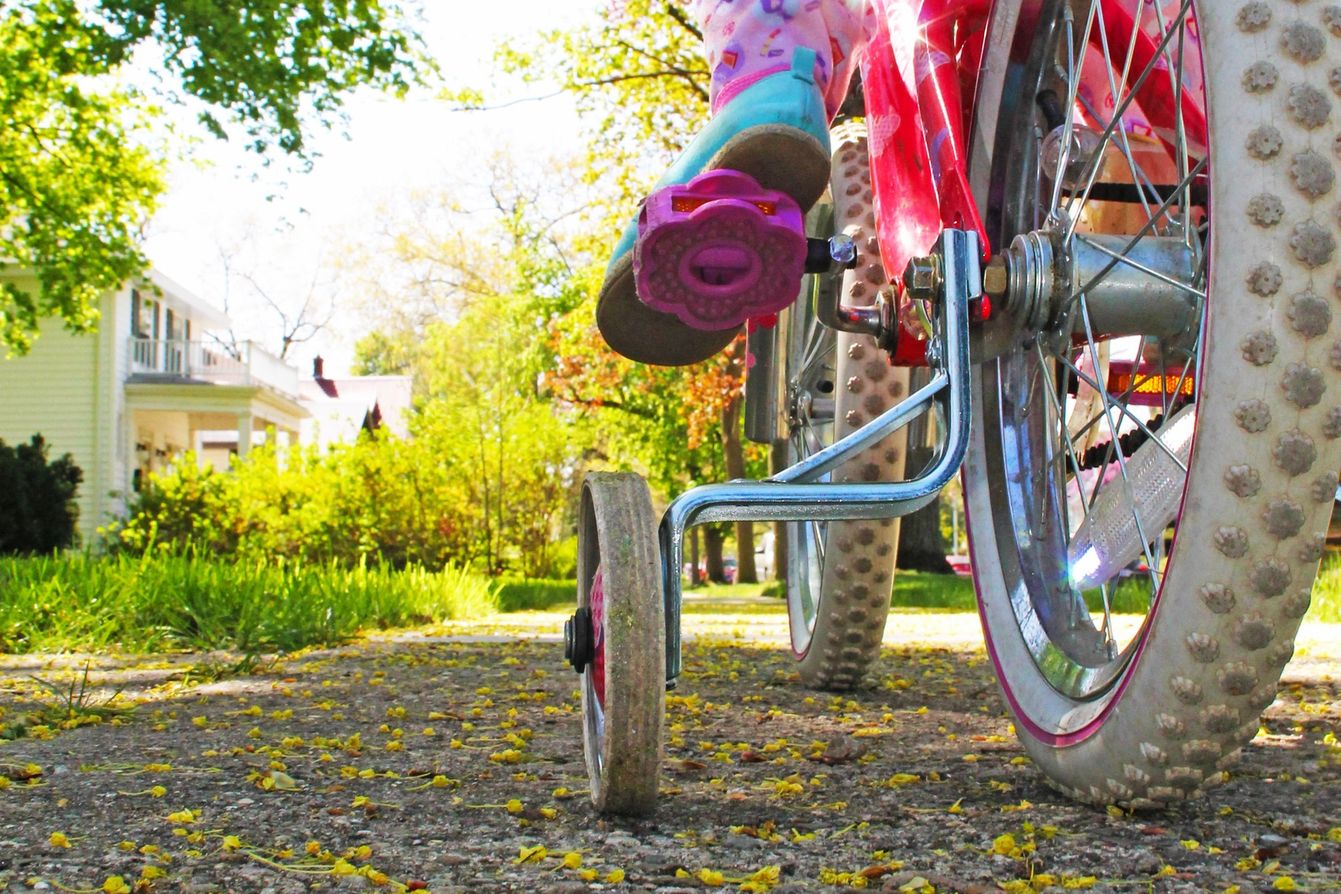Everything you need to know as a parent when your child starts to learn to ride a bike. Here’s how to get them off those training wheels.
Bicycles are the ultimate freedom machine. You don’t need fuel, registration or a licence. You can hop gutters, cut across parks, through alleyways and along footpaths. Yes, the law requires you to wear a helmet, but that’s a small price to pay, not to mention a sensible way to keep your brains inside your skull.
They say cycling is the most energy-efficient form of transport. If you don’t believe that, try putting a muesli bar and a bottle of water in your car’s fuel tank and see how far you get. Seriously though, it’s a great way to travel to local destinations, it’s cheap and it can keep you fit while getting you to where you need to go.
If you’re a parent, you probably want to see your kids outside and active. Cycling is an obvious solution. Bikes are a timeless classic for one simple reason: Kids love them. With most towns—even smaller ones—creating bike paths, you can be happy knowing your child doesn’t need to ride on the road.
Before you start with the first grand bike riding adventure, there are a few things to consider.
Choosing the right bike for your child
A child learning to ride should be able to stand flat-footed on the ground without the bike’s seat reaching their crotch—a gap of several centimetres is about right. They should be able to reach the handlebars without leaning forward.
A balance bike is a great way to learn the basics without having to worry about pedals, chains and sprockets. Kids can start using these bikes from a very young age; even 18-month-olds can ride these.
If you’re a particularly hipster parent, you’ll no doubt be attracted to the wooden version, but there are also more conventional-looking steel or aluminium balance bikes available. Some come with a pedal-and-chain kit that can be attached when the child is ready to take it to the next level.
A common mistake parents make is to provide a bicycle that’s too large and heavy for their child in the belief that “they’ll grow into it”. Yes, they probably will . . . eventually. But not before they’ve experienced a whole lot of frustration, fallen several times from what feels like a great height and developed an “I can’t do it” complex. Consequence? A bike that languishes in the garage forever.
Beginner bike riders most definitely need the right-size bike or the whole experience will be horrible, for you as the teacher and them as the student. Beginner riders with smaller bikes will have an overall better learning experience and much higher levels of confidence than a child who is constantly struggling to reach the ground with their feet.
Kids tend to be rough on bikes, running them into walls, dropping them on the driveway and leaving them in the rain. Do your best to teach them to look after their things, but also be smart and avoid the temptation to buy them a mini version of your dream bike with all the bells and whistles (I’m talking to you, dads!). Think light, strong, simple, practical.
Keeping your children safe when learning how to ride
Before teaching your children the basic skills for riding a bike, it’s important to keep them safe with the right protective gear and knowledge.
1. Helmet
A helmet is non-negotiable. Make sure the helmet fits your child’s head properly. It should not be perched on top because it’s too small, or sliding back or forwards because it’s too large. Do up the chin strap snugly and evenly on each side so that the helmet is just above the eyebrows.
Beware of secondhand helmets: Even if they’re not visibly cracked, the effectiveness of the safety foam lining may have been compromised by a history of crashes or rough treatment.
2. Proper shoes
Sturdy closed-in shoes are best. There’s a risk that inexperienced feet can get tangled up in the pedals and chain. Flip-flops or sandals are easily broken or lost while riding.
3. Protective gear
Dress your child in thicker fabrics, or long pants and long sleeves, to prevent bad scrapes and bumps. Make sure they don’t overheat, especially during summer, though.
Elbow and knee pads are probably overkill. Knee pads in particular may interfere with the pedalling motion. Leave the body armour for the BMX or mountain bike competition circuit.
Realistically, learn to accept that learning to ride a bike will inevitably involve some tears and band-aids.
4. Road safety
Children need to know how to safely cross streets, even when supervised by a parent. They must know to keep to the left, how to pass other path users—pedestrians, cyclists, dogs—safely by ringing their bell, and how to give way to others.
Children should also learn how to safely and effectively use their brakes, especially if they need to brake suddenly. Brake levers are a crucial safety feature, and kids should know which brake does what. Teach them to use the rear wheel brake more as it’s the safest for braking suddenly. Your child could go flying over the handlebars if they engage the front wheel brakes too quickly.
Where to teach a child to ride a bike
Your child will be most confident on level ground, rather than steep slopes or bumpy terrain, when learning to balance on a bike. A great spot to practise is an empty parking lot, as they usually offer a flat open space, which is any child’s bike-riding dream.
Other flat-ground alternatives are empty sporting facilities such as concrete-surfaced basketball or tennis courts. Ordinary footpaths alongside roads may also be suitable, depending on the proximity of vehicle traffic, hills and the quality of the path (see below).
The best place for kids to ride is along a dedicated bike path where it’s flat, the surface is smooth and the cars are far away. It’s also likely to be a place that’s more scenic and where the whole family can ride and enjoy a picnic.
School holidays are a great time for the whole family to get out for some good physical activity, and what better or fun way to exercise than riding bikes together?
Here are some warnings about higher-risk riding locations:
Loose gravel or sand
Most cyclists will find this difficult, let alone a beginner. Avoid. A well-packed gravel road, however, is fine for a confident rider on thicker, knobbly tyres.
Hills
Going up any kind of incline is hard for beginners. Going down runs the risk of losing control and having a nasty crash. Start on the flat and gradually introduce hills as skills, strength and confidence increase.
Vehicular roads
Don’t ride a bike on a road so busy that they need to hold your hand when crossing it on foot. Obvious. But if you live on a particularly quiet street or cul-de-sac, you might decide kids can ride on the road under close supervision.
As children grow, you might be comfortable allowing them to use dedicated bike lanes on public roads. But there are plenty of adults who see this as far too risky, even for themselves.
How to ride a bicycle without training wheels
If your child has ridden a pedal tricycle for some time, the transition to a two-wheeler should be easy. The sneaky thing to do is, over a period of several weeks, slowly raise the height of the training wheels. This will force your child to spend more and more time balancing on two wheels only. Eventually, you can take the training wheels off altogether.
Remember, new skills are challenging for children to learn and a lot of small steps are needed to accomplish the task. Congratulate your child’s efforts and don’t make them feel slow or silly for not grasping the concept of balance instantly. It takes time, usually over a period of a few solid days of trying. Keep in mind that they are doing their best and want to make you proud.
Once they get going, you can also take the opportunity to teach other riding skills that mimic everyday life. Think crossing the street, giving way, riding in a straight line and more. These might all sound like simple steps, but they are essential safety skills that could save your child’s life.
Some kids have the attitude and ability to jump on a bike confidently and ride away without assistance after only a few times up and down the footpath with mum or dad providing a steadying hand. Other kids are naturally more cautious, but their confidence will grow if they’re provided with the right support and training aids.
You can raise the seat once a child is riding confidently so that the knee is only slightly bent at the bottom of each pedal stroke. Do it a little bit at a time over several weeks if the child is resistant. When buying a bike, make sure the tubing underneath the seat is long enough to allow this kind of adjustment.
It’s time to teach your child how to ride a bike
Bike riding can teach a lot of good life lessons. After all, life is all about finding balance, not overdoing things or leaning too far in any direction, but keeping focused and steady. Yes, there are potential dangers, but every course of action involves risk.
If your child is well taught, follows the safety rules and is supervised by a responsible adult, the risks are low and fun can be endless. It’s a good idea to teach your child to ride a bike as early as possible so they can enjoy the experience sooner rather than later.
With careful mentoring and quality time spent together learning to ride, your child will grow up with happy memories, sensible boundaries, as well as the confidence that they can take on life’s challenges and succeed.

How helpful was this article?
Click on a star to rate it!
5 / 5. 1
Be the first to rate this post!
Adriana Wales
Related posts
Subscribe
Receive personalised articles from experts and wellness inspiration weekly!

